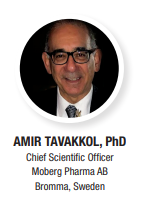With Amir Tavakkol, PhD

“There have been numerous efforts to develop a topical formulation of terbinafine but most, if not all, have been unsuccessful because of failure to achieve adequate drug delivery to the subungual tissue.
Efficacy and safety results from the phase 3 trials investigating MOB-015, topical terbinafine 10% solution, show that it has a favorable benefit-to-risk ratio and is a good option for managing toenail onychomycosis,” said Amir Tavakkol, PhD, Chief Scientific Officer, Moberg Pharma AB, Bromma, Sweden.
Results from the North American phase 3 trial were recently published.1 The study enrolled 365 adolescents and adults with mild-to-moderate distal and lateral subungual onychomycosis involving 20% to 60% of at least one great toenail. Participants were randomized 2:1 to treatment with MOB-015 or vehicle once daily for 48 weeks.
Efficacy assessments at week 52 showed statistical superiority (P ≤.0195) of MOB-015 versus vehicle in the primary endpoint analyzing complete cure (4.5% vs. 0%) and in key secondary endpoints evaluating mycological cure (69.9% vs 27.7%) and treatment success (mycological cure and ≤10% clinical disease involvement) (15.4% vs. 4.2%). Patient-reported rates of cure/almost complete cure were 26.8% for MOB-015 and 13.4% for vehicle.
There were no serious adverse events related to MOB-015, and rates of application site adverse events were low. Two patients in each treatment group withdrew from the study for a treatment-related adverse event.
“MOB-015 has no clinically relevant systemic absorption, and so it avoids potential issues associated with orally administered terbinafine,” Dr. Tavakkol said.
Interpreting the outcomes
“Mycological cure measuring fungus eradication is objective, the only consistently well-defined efficacy parameter in toenail onychomycosis clinical trials, and a widely accepted main treatment goal,” said Dr. Tavakkol.
“The mycological cure rate achieved with MOB-015 matches that reported for oral terbinafine and is much higher compared to all other US-approved topical drugs that have mycological cure rates of 30% to 55%.”
While numerically low, the complete cure rate achieved with MOB-015 is favorable when compared with the complete cure rates reported for topical ciclopirox, tavaborole, and efinaconazole (5.5% to 18%), especially since the vehicle response rate for MOB-015 is zero whereas for the other three drugs they are between 0% and 5.5%, respectively, Dr. Tavakkol noted.
Furthermore, judgment of complete cure responses in some patients using MOB-015 is confounded by vehicle-induced transient whitening/discoloration of the nail.

Dr. Tavakkol explained that many antifungal agents, including terbinafine, strongly bind to keratin. This property reduces their antifungal potency and may restrict nail penetration. “Terbinafine is reported to have a keratin binding rate of 88.4%, and indeed, early efforts by other companies to develop a topical terbinafine formulation failed during mid to late stages of clinical development,” he said.
“The key to Moberg’s success is that formulation for MOB-015 contains urea, propylene glycol, and lactic acid. These compounds have water-binding properties that increase nail plate hydration and permeability, thereby enabling terbinafine delivery and subsequently rapid onset and long-lasting mycological cure. However, the hydrating properties also alter nail appearance in some patients.”
Dr. Tavakkol said that while it is relevant, complete cure requiring a completely normal-appearing nail is a subjective endpoint that is also fraught with problems arising from pre-existing nail conditions unrelated to onychomycosis, such as trauma or aging.
“Despite its low rate of complete cure, MOB-015B’s high mycological cure rate together with the finding of a rising slope of the complete cure rate at week 52, 4 weeks after therapy was discontinued, suggests that the complete cure rate would likely continue to increase over time, especially as the fungus is eradicated and healthy toenail grows out,” Dr. Tavakkol said.
A phase 3 European study investigating MOB-015 also met its primary endpoint. Moberg will also be conducting a pediatric study enrolling patients, age 6 to 17 years.
By Cheryl Guttman Krader
______________________________________________________________________________________________________________________________
REFERENCE
1. Gupta AK, Surprenant MS, Kempers SE, Pariser DM, Rensfeldt K, Tavakkol A. Efficacy and safety of topical terbinafine 10% solution (MOB-015) in the treatment of mild to moderate distal subungual onychomycosis: a randomized, multicenter, double-blind, vehicle-controlled phase 3 study. J Am Acad Dermatol. 2021;85(1):95-104. doi: 10.1016/j.jaad.2020.06.055.

